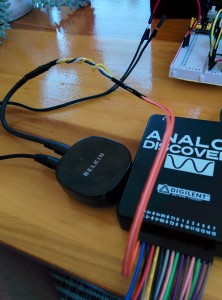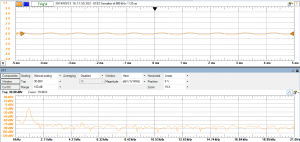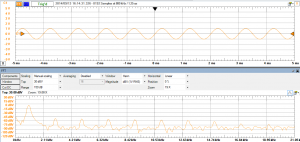
For my cigar box bluetooth speakers, I’ve been taking the easy route for bluetooth connectivity. I simply took the housing off a Belkin F8Z492 audio receiver and plugged it into a cheap class D amp. It worked really well and got me to a finished product quickly. Initially, it sounded great. The Dayton Audio ND65 drivers alone provide a big upgrade over the tinny laptop speakers and earbuds I’m used to. But after a few weeks, even my untrained ears could hear some distortion. It sounds like a subtle reverb, usually affecting only vocals. Initially, I suspected the front end: the cigar box enclosure, or the drivers. Or, just as likely, something wrong with the wiring. This is a lesson in engineering fundamentals. Armed with only a primitive knowledge of audio and electrical distortion, I needed a plan to isolate and quantify the problem.
Narrowing it down
Isolation was difficult, because the problem was subtle. Typically, I have to listen to a song or two before deciding that I can hear the effect. But when connecting my phone’s audio directly to the amplifier, the distortion was clearly not present. That ruled out the drivers, the enclosure, the amplifier, and even my hacky splice job on the 1/8″ audio cable. So, either it’s true what they say that bluetooth audio and the SBC are inherently distorted. I read about aptX and considered upgrading to an “audiophile” bluetooth receiver. But my phone, a Nexus 5, doesn’t support aptX. I could have used an iPhone to test, but my gut was telling me that this distortion was something more than the usual “bluetooth sucks”. I decided to take a survey of some cheap bluetooth speakers.
The speakers I bought were indeed cheap. Among them was the Ematic Portable Bluetooth Speakerbox. It’s a $15 Jambox clone. I couldn’t even connect to it until I removed the metal grill, which acted like a Faraday cage, totally blocking the antenna. Didn’t anyone test it? Well, for $15, maybe not. Anyway, once I removed the grill, it worked pretty well. In fact, it exhibited none of the distortion I observed from the Belkin device. As a further demonstration, I plugged in the Belkin’s output to the Ematic’s 1/8″ input. Sure enough, the distortion was back.
How bad is it?
So, at this point, it’s obvious that there’s something wrong with the Belkin product. I don’t know why it’s so popular if it can’t even keep pace with the bargain basement module in the Ematic, but regardless, it was time to find a replacement. But how to choose? Will I go to the effort to integrate a replacement, only to find out after repeated listening that it has some other problem? I needed a repeatable, quantifiable process to evaluate a replacement. After some research, I learned pretty quickly that DIY/enthusiast audio testing isn’t a common thing. The pros are using high-end AP equipment costing $10,000+, and there simply aren’t sub-$1000 options from these manufacturers. Most enthusiasts are using RMAA and a sound card. But for me, there are too many variables affecting the interpretation of RMAA results. Basically, a sound card – even a high end one – may apply some distortion to improve the sound, and they don’t necessarily publish the details, because it’s not a scientific instrument. In the end, I went with a low-cost PC-based oscilloscope: the Digilent Analog Discovery. For $279, you get a precision instrument with well-documented electrical characteristics. The bandwidth may be too low for hifi applications, and it lacks the convenient tools found in a professional distortion analyzer for things like THD+N. But I’m not measuring hifi gear.
The test
So, I started running through the tests. 1kHz tones were generated from Nexus 5 using Pro Audio Tone Generator. One of the first tests I ran was crosstalk, and this immediately stood out. Check out the images, both unloaded, with a 1kHz tone playing over the right channel:


Wow, this can’t be right! Crosstalk is only -8dB. At this point, I doubted the results and checked many possible sources of error, like crosstalk induced by the shared ground in the 1/8″ TRS cable. Turns out, that’s a real effect, but only to the tune of -40dB at worst. Finally, I simply connected earbuds to the Belkin module and compared crosstalk versus plugging the headphones into my phone directly. Wow! Not only was it audible, but it was much louder than my expectation. -8dB is about 15.8%, but subjectively, I’d say it sounded half as loud as the tone on the correct channel. By comparison, crosstalk for the same tone on a pair of cheap headphones connected to my Nexus 5 is completely inaudible.
Conclusion
Is crosstalk the cause of my mysterious reverb? Maybe. I couldn’t find much info on what crosstalk sounds like in real systems. Apparently, crosstalk above -40dB or so is rare in even the cheapest audio equipment (your cell phone speakers, for instance), that the audiophiles don’t spend much time thinking about it. To see it in such a popular product would defy belief, except that it’s so easy to observe and reproduce across units. In the ~6 years this product has been on the market, it must have sold more than 100k units, yet no one has measured and published its distortion characteristics. Belkin doesn’t publish any measurements – not FR, not THD+N, nothing. Clearly, the product is aimed at non-audiophiles. And no one else has measured it, either, as far as I’ve seen. Maybe since it’s not marketed as a low-distortion, “audiophile-quality” product, the people with the skills and equipment to measure it have never bothered. That’s my theory, anyway. But you don’t have to be an audiophile to hear this distortion. Even my parents can hear it on the speaker I built them (they’re so nice, they said they heard it and thought it was intentional). So, I’m moving on, throwing all these Belkin units in the parts bin, and looking for a new bluetooth audio module :-/
Do you have one of these? Have you heard the reverb? Do you have experience with outrageous crosstalk? Are you a Belkin engineer who wants to repent publicly? Let me know in the comments.